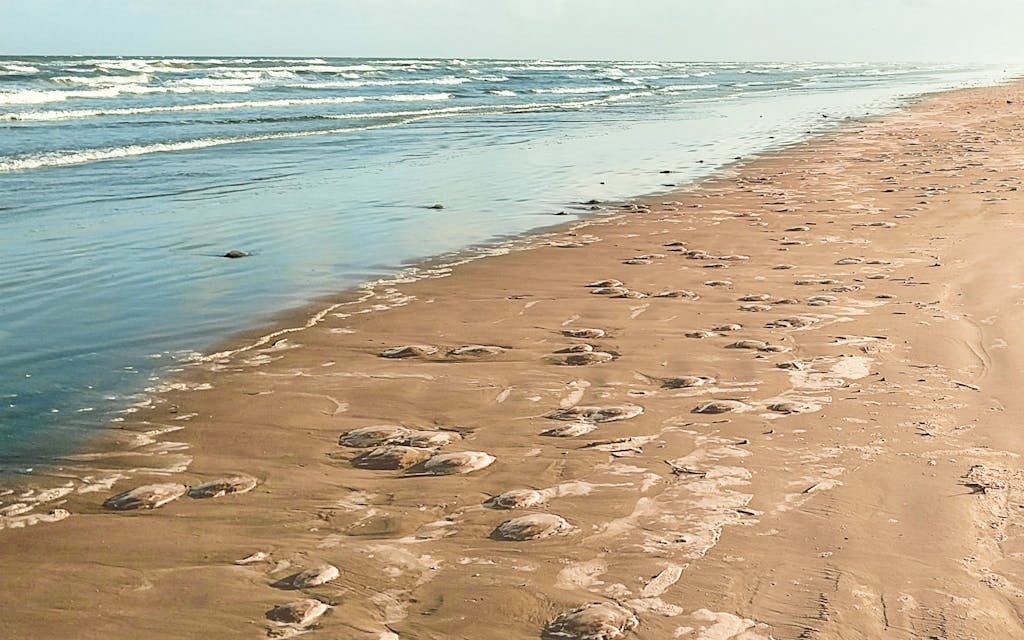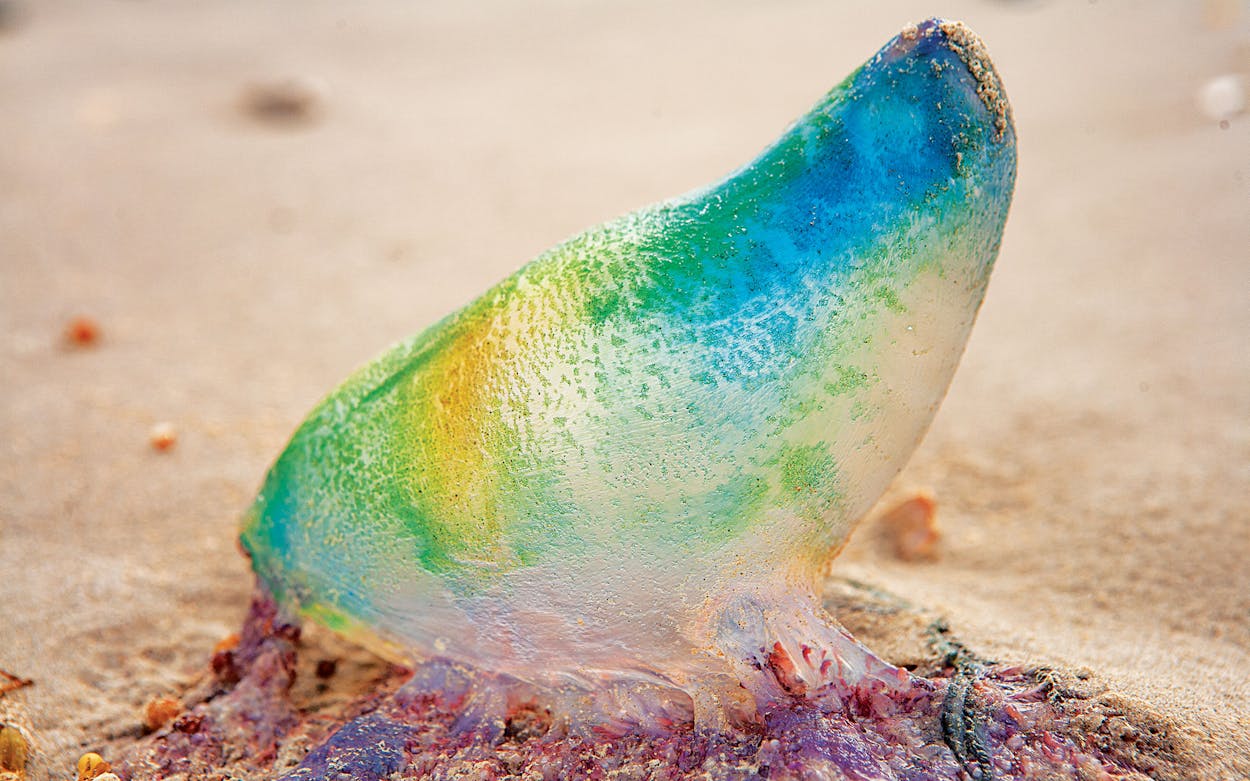During a family vacation on South Padre Island last winter, my athletic nephew managed to persuade about a dozen of us to take a beginner’s surfing class despite the southerly wind that was raging that day. As we gathered with our instructors around a fleet of foam surfboards resting on the sand, I watched kite surfers delight in the gale, launching themselves into the air and flying to heights that made me gasp.
One of the teachers shouted over the wind for us to practice “popping up”—jumping from our bellies to our feet in what should be a fluid and balanced motion. Prone on the board, I turned my head away from the tiny grains pelting my body and made a small—but wise—decision, although I wouldn’t know how wise until about thirty minutes later. Rather than expose myself to more sandblasting, I would wear yoga pants over my swimsuit out in the water.
A short while later, after we’d paddled out to where the waves were breaking, my instructor grabbed the tip of my board and turned me toward shore. She looked seaward, years of experience finely tuned to the oscillating energy beneath the surface. At a moment that she perceived to be just right, she shouted, “Paddle!” Then, “Pop up!” And I did. For a second. Then, I keeled over into the knee-deep water. Joining the end of the line to wait for the teachers to feed us back into the waves, I bobbed next to my daughter as we straddled our boards.
“Ouch,” she said, pulling her leg out of the water and inspecting the back of her knee. “Are there jellyfish out here?”
I peered down into the water, which had the opacity of pea soup. The wind had churned so much sand into the surf that it was impossible to see what might be lurking below the surface. Earlier on the trip, we had encountered jellyfish washed up at the high-tide mark, pancake-shaped and colorless but for a pinkish, four-leaf clover shape on top. “Moon jelly,” I had pronounced. Since writing a book about jellyfish several years ago, I’m often a bit too eager to deliver a spontaneous tutorial, at least according to my family.
I had flipped the gelatinous medusa over with the toe of my tennis shoe—yes, they can still sting when washed up—and pointed to the mouth and the four long extensions that surrounded it. “Those are called oral arms,” I told them. “See how they dangle off the mouth like extended lips? They are full of stinging cells the jellies use to catch their plankton prey, such as tiny crustaceans, oyster and clam larvae, and fish eggs. Jellies only have one body opening, so what they can’t digest comes out the same hole.” The jellyfish family is more than half a billion years old, from a time when separate entrances and exits in the digestive system hadn’t yet evolved.
Out in the surfing lineup, I wondered if I felt something soft and round push against my yoga-pant-clad calf. But then it was my turn again. “You’re listing,” my instructor warned. “Focus on being in the center of the board.” I nodded and then heard “Pop up!” as I was pushed into a wave. Suddenly, I was standing. I rode toward shore planted firmly on my feet. Smiling broadly at my unexpected success, I bounded seaward to bask in what were sure to be abundant accolades. But I noticed the line had thinned. I saw my family clustered together on the beach, examining welts. It was clear by then that the wind hadn’t only whipped up the sand—it had driven a bloom of jellyfish directly into our surf lesson. Everyone but me had been stung.
In recent years, headlines have proclaimed that jellyfish blooms are on the rise in oceans around the world for a host of possible reasons. Jellyfish are made mostly of water, which, unlike cells, doesn’t require oxygen, so one theory argues that their low metabolism allows them to take advantage of seas where pollution has depleted the oxygen content. Also, as the fish and sea turtles that prey upon (and compete with) jellyfish for food are overharvested, jellyfish thrive. According to some estimates, large predatory fish stocks have dropped by 90 percent since the mid-twentieth century. Six of the seven sea turtle species are in decline or endangered from nesting-
habitat loss and destructive fishing. Some jellyfish seem to reproduce faster in our warming waters, as well.
No scientific study has confirmed jellyfish are increasing globally. Because they were ignored for much of the twentieth century, there’s no real baseline. But along many coasts where humans have had a big impact, such as the Mediterranean, southwestern Africa, and the East China Sea, ocean ecosystems have clearly become more gelatinous.
But what about Texas? Jellyfish have populated our waters for millennia. Was there anything unusual about our prickly encounter?
The Texas Parks and Wildlife Department has been trawling the state’s coastline every month since roughly 1983 and taking stock of the creatures it nets. The catch intermittently includes three main species of jellyfish, also known as scyphozoans: moon jellies, sea nettles, and cabbageheads (in order of abundance). Portuguese man-of-wars, technically a colony of a kind of jellyfish called a hydrozoan, and comb jellies, which are gelatinous but belong to a biologically distant group, are also Texas locals.
In 2018, state marine biologist Zachary Olsen copublished an analysis of about thirty years of jellyfish data. Before I spoke to him recently, Olsen reanalyzed the figures for me, adding in the past three years of surveys. “Every couple of years we’ll see a bit of a bump in jellyfish numbers,” he said. In 2017, for example, an increase in numbers correlated with low salinity in some of the lower coast bays. “But other than that, it’s very patchy,” he added.
Unlike what scientists are seeing on other coasts, Olsen’s data doesn’t point to a consistent increase in jellyfish in the Gulf.
Maria Pia Miglietta, a jellyfish biologist at Texas A&M University at Galveston, confirmed the capriciousness of these creatures. “We’re not that good at predicting where and when they are going to [show up], which makes studying them so hard,” she said. “When you propose to do research,” she said, with the laugh of someone who has been ghosted by jellyfish, “they may appear, or not. And I don’t know why.”
Miglietta says understanding where and when jellyfish appear depends a lot on the creature’s curious life cycle. The adult phase, when it’s known as a medusa, is just a fleeting moment in its existence. Most medusae live only about a year, but during that time, they release thousands of larvae, called planulae, which look like fuzzy Tic Tacs. A jellyfish larva’s job is to find a hard surface and attach there. The larva then grows into a polyp, a tiny sea anemone–like form. Polyps, which can live for decades, are medusa factories.

At a still-unknown environmental cue—maybe a temperature change or a heavy rainfall—polyps undergo a bizarre process called strobilation about once a year. They slice themselves horizontally into what looks like a stack of about a dozen pancakes. The top pancake starts wiggling and jiggling and eventually pops free, swimming into the sea as a baby jellyfish. Then each pancake follows in turn. That’s why if you see one medusa, it’s unlikely to be alone.
But the polyp is mysterious too. Among the two hundred or so species of scyphozoans, the polyps of fewer than a dozen varieties have ever been seen in the wild. Given the proliferation of hard surfaces in the form of oil platforms, docks, and jetties, some scientists suggested that polyp habitats in the Gulf of Mexico should be on the rise. But no one has ever reported spotting a scyphozoan polyp in Texas. “We have no clue where the polyps are,” said Miglietta. “That’s a very big gap in our knowledge.”
In Texas, jellyfish stings are reported and archived at six locations in the Texas Poison Center Network, a consortium created by the state in 1993. When I reached out to Jeanie Jaramillo-Stametz, the managing director of the Texas Panhandle Poison Center, she downloaded historical reports of sting incidents in the state. If any trend was apparent, it was downward, with the reports of stings falling from a high of about 73 in 1998 to fewer than two dozen in 2021. The data indicated more incidents in the summer, which is, of course, when more people are at the beach.
Like the data from the seas, jellyfish sting numbers are patchy. If victims don’t report their stings, they don’t get recorded. As a 2006 study of the Poison Center sting data noted, the reports likely “represent an unknown fraction of all stings that actually occur.”
With no thought of reporting our own stings, we cut our surf lesson short and hustled the welted home to hot showers, which went a long way to easing the pain. Current recommendations for treating jellyfish stings are to use seawater—not freshwater—to rinse the tentacles off if you can still see them. You can also use a credit card or tweezers to gently pull away any remaining tentacles. And though meat tenderizer is popularly used to break apart tentacles, it’s been proven effective in only about half the published cases. (I feel obligated to add here that it’s never advisable to urinate on a sting, despite what Joey on Friends said.)
After removing the tentacles, applying heat and a slurry of seawater and baking soda should neutralize the toxins. Vinegar can help too. Over-the-counter pain relievers or antihistamines ease the burning sensation. Some people are more sensitive to jellyfish stings than others; those who consider themselves susceptible should consider bringing an epinephrine pen and antihistamines to the beach. Experts advise medical care if symptoms persist for an extended period of time or for any systemic problems, such as respiratory discomfort or heart palpitations. In our case, within a couple hours, everyone’s welts and pain were fading.
I tried, with admittedly little success, to assuage any lingering discomfort by sharing the fact that a jellyfish sting is a brush with some of the most sophisticated biological weaponry on the planet. Medusa stingers deploy with an acceleration that is five million times faster than gravity. Drop a pencil. A jellyfish stinger deploys five million times faster. It’s the fastest known motion of any animal. The stinger is a hollow microtubule, just about one hundred microns long (or roughly the thickness of a sheet of printer paper). That’s why wearing an extra clothing layer such as a wetsuit, surf shirt, or, in my case, that pair of yoga pants, is the best protection.
Later that night, as we recounted our jellyfish encounter over margaritas and burgers, my nephew raised an eyebrow at me and said, “You weren’t stung, were you?” When I said no, he said, “Maybe the jellyfish knew you were on their side, writing about them and all.”
I shook my head, lifting my glass in a toast to the jellies. If there’s one thing I’ve come to understand, it is this: The jellyfish are out in the ocean, doing what they’ve done for millions of years. Growing, strobilating, making larvae, catching plankton, getting pushed around by wind-driven currents, and, lately, confounding scientists. It’s we who just happened to be in the wrong place at the wrong time.
Juli Berwald is the author of Spineless: The Science of Jellyfish and the Art of Growing a Backbone. Her latest book, Life on the Rocks: Building a Future for Coral Reefs, published in April. She last wrote for Texas Monthly in September 2021 with the cover story on the Gulf’s coral reefs.
This article originally appeared in the June 2022 issue of Texas Monthly with the headline “The Slippery Secrets of Jellyfish.” Subscribe today.
- More About:
- Critters
- Wildlife
- South Padre Island







